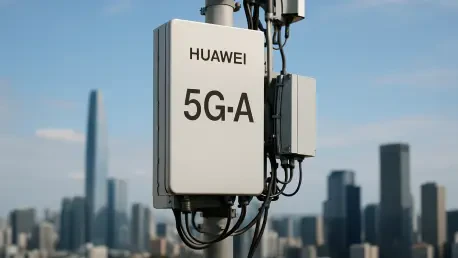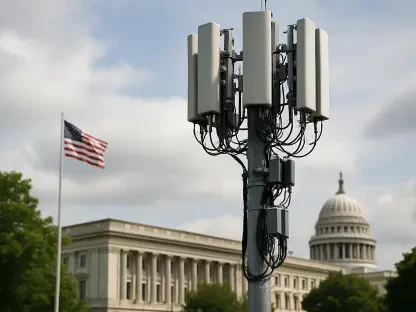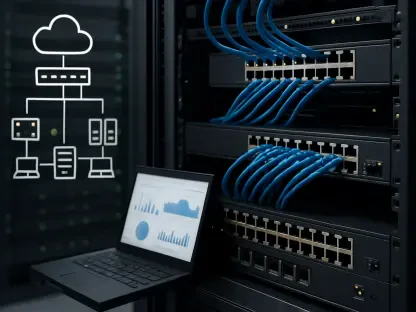In a world where connectivity forms the backbone of modern society, Huawei has stepped forward with a transformative vision that could redefine the telecommunications landscape through the integration of 5G-Advanced (5G-A, also known as 5.5G) and Artificial Intelligence (AI). Revealed at prominent industry gatherings like MWC Barcelona and the Global Mobile Broadband Forum, this strategy is not merely an incremental update but a bold reimagining of how networks can drive an “intelligent world.” Huawei’s plan promises to push beyond traditional boundaries, turning telecom operators into technology-driven entities, often dubbed “techcos,” that prioritize user experience over basic connectivity. This seismic shift aims to address market saturation by unlocking innovative revenue streams and positioning the industry at the forefront of digital transformation. From smart cities to autonomous vehicles, the implications of blending high-speed, low-latency networks with AI capabilities are vast, touching nearly every facet of daily life. As this ambitious blueprint unfolds, it sparks curiosity about how such advancements will reshape industries, enhance personal interactions with technology, and set a new standard for global connectivity.
Pioneering the Mobile AI Era with Dual Frameworks
Huawei’s strategy hinges on a dual approach labeled “Networks for AI” and “AI for Networks,” crafting a robust ecosystem designed to meet the demands of the Mobile AI era. The first pillar, “Networks for AI,” focuses on evolving telecom infrastructure to support AI applications with unparalleled performance. With 5G-A, Huawei achieves peak downlink speeds of 10 Gbit/s and uplink speeds of 1 Gbit/s, alongside latency reductions to under 4 ms on the user plane. This technical superiority ensures networks can handle the rigorous needs of real-time AI workloads, such as industrial data sharing or live content creation. Furthermore, the scalability to support up to 100 billion device connections paves the way for a fully integrated Internet of Things (IoT), making massive machine-type communications a reality. Such capabilities position 5G-A as the foundation for an interconnected future where devices and applications seamlessly interact at unprecedented scales.
Complementing this, “AI for Networks” leverages artificial intelligence to revolutionize network operations, pushing toward greater autonomy and efficiency. By integrating AI into the network fabric, Huawei enables Level 4 (L4) autonomy through digital sites and RAN Agents, which facilitate unattended maintenance and real-time optimization. This reduces human intervention while enhancing energy efficiency, effectively transforming network management with virtual “digital engineers.” Tools like intelligent wireless boards adapt to dynamic usage patterns in milliseconds, ensuring responsiveness to varying demands. Additionally, Huawei’s Ascend AI processors and MindSpore framework optimize edge computing, slashing delays for critical applications. This synergy of AI-driven operations and high-performance networks marks a significant departure from traditional telecom models, setting a new benchmark for operational excellence.
Transforming Operator Value and Business Models
A key element of Huawei’s vision is the transformation of telecom operators from mere connectivity providers into techcos that deliver experience-based services. This shift moves away from traffic-based monetization to models that prioritize personalized user interactions, ultimately boosting Average Revenue Per User (ARPU). By embedding AI into base stations for scenario-specific services, operators can tailor experiences based on user context, leveraging edge computing for real-time responsiveness. This approach not only enhances customer satisfaction but also opens new revenue streams through advanced digital offerings. For operators, adopting this model means staying competitive in a market increasingly driven by quality of service rather than sheer bandwidth, ensuring relevance in a rapidly evolving digital economy.
Beyond immediate business benefits, this transformation carries broader implications for the telecom industry’s role in society. Operators equipped with 5G-A and AI technologies can offer differentiated services that extend into sectors like healthcare, education, and entertainment, fundamentally altering how value is perceived and delivered. Huawei’s strategy encourages a rethinking of partnerships and collaborations, as operators may need to align with tech firms to develop innovative applications. However, this evolution is not without challenges, as operators must navigate the complexities of integrating sophisticated AI systems while maintaining cost efficiency. The push toward becoming techcos represents a critical pivot, demanding agility and foresight to capitalize on emerging opportunities while addressing potential pitfalls in a competitive landscape.
Societal Impacts and Industry-Wide Trends
The societal implications of Huawei’s 5G-A and AI integration are profound, promising to usher in an era of ubiquitous intelligence across multiple domains. Consumers stand to gain from personalized AI assistants on a variety of devices, enabling seamless, on-demand experiences in work and leisure. Smart cities could see enhanced efficiency through optimized traffic management and public safety systems, while healthcare might be revolutionized by remote diagnostics and telemedicine powered by real-time data. Industries like manufacturing and logistics are poised for unprecedented automation through embodied AI, driving productivity to new heights. Huawei projects that by 2030, AI agents could outnumber human connections, creating an Internet of Everything (IoE) where intelligent systems interact effortlessly, reshaping daily interactions in ways previously unimaginable.
Yet, this optimistic outlook is tempered by significant challenges that must be addressed to ensure equitable and secure deployment. Cybersecurity risks are amplified with the increased connectivity of IoT devices, expanding the potential attack surface for malicious actors. Geopolitical concerns, particularly regarding data privacy and national security, add complexity, especially in markets wary of Huawei’s global influence. Ethical considerations, such as algorithmic bias and transparency in AI decision-making, also demand attention as these technologies embed into critical infrastructure. Aligning with broader trends like edge AI and the Artificial Intelligence of Things (AIoT), Huawei’s strategy reflects a consensus on the transformative potential for industrial automation and smart infrastructure, but the road ahead requires careful navigation of technical and societal hurdles to fully realize these benefits.
Competitive Dynamics and Market Implications
Huawei’s aggressive push into 5G-A and AI integration is reshaping the competitive landscape, positioning the company as a formidable leader in both telecom infrastructure and AI solutions. By offering end-to-end solutions that span network hardware, cloud services, and AI components like Ascend chips, Huawei gains a unique edge for seamless optimization and market penetration. This challenges global tech giants in AI hardware and cloud infrastructure, potentially leading to market fragmentation as competitors adapt their strategies. Operators adopting Huawei’s technologies, such as major players in Asia, stand to gain significant advantages by transitioning into techcos, offering advanced digital services that prioritize user experience over basic connectivity, thereby securing a stronger market position.
For smaller players and startups, Huawei’s advancements open new avenues for innovation, particularly in AI-powered applications for smart homes, intelligent vehicles, and augmented reality (AR). The demand for AI-as-a-Service (AIaaS) facilitated by low-latency edge computing creates opportunities for niche solutions, though these entities may struggle to compete in a fragmented global market dominated by established giants. Meanwhile, operators slow to embrace this shift risk commoditization of their core services, losing relevance in an experience-driven industry. The broader market implications suggest a need for strategic collaborations and regional integration to maintain competitiveness, as Huawei’s ecosystem continues to influence global standards and adoption rates, shaping the trajectory of telecom evolution.
Future Horizons and Strategic Roadmaps
Looking to the immediate future, Huawei anticipates significant milestones in the rollout of 5G-A networks and AI-enabled devices, with over 50 large-scale deployments expected by 2026. This period will also see the shipment of millions of compatible smartphones and devices, embedding AI capabilities into everyday technology. Enhanced network operations through AI agents and digital twins will optimize spectrum usage, energy consumption, and maintenance, ensuring continuous performance improvements. Scenario-based AI services, tailored to specific user contexts via edge computing, are set to emerge, promising more personalized digital experiences. These near-term developments signal a rapid acceleration of Huawei’s vision, laying the groundwork for broader industry adoption and setting benchmarks for innovation in network management.
Beyond the immediate horizon, the long-term outlook toward 2030 paints a picture of ubiquitous mobile AI agents outnumbering traditional applications, fundamentally altering human-device interactions. 5G-A is positioned as a critical bridge to 6G, embedding foundational AI and integrated sensing capabilities for future advancements. Fully autonomous network management, advanced multimodal interfaces, and AI-generated content (AIGC) are expected to drive immersive communications and intelligent vehicle-to-everything (V2X) solutions. However, realizing this vision faces hurdles, including technical challenges in meeting performance demands for embodied intelligence and ensuring data security in distributed architectures. Market adoption and geopolitical barriers will also influence the pace of progress, requiring sustained industry collaboration to overcome obstacles and deliver on the promise of an interconnected, intelligent future.
Reflecting on a Groundbreaking Shift
Huawei’s unveiling of its 5G-A and AI integration strategy marked a defining moment in telecommunications history, setting a bold course for an intelligent revolution that redefined connectivity. The dual focus on building networks for AI applications and enhancing operations through AI-driven autonomy captured the industry’s imagination, promising a future where telecom transcended traditional boundaries. Commercial deployments accelerated as operators embraced the techco model, while the proliferation of AI services began reshaping user experiences across diverse sectors. Addressing cybersecurity, privacy, and ethical concerns emerged as pivotal challenges that demanded rigorous attention during this transformative period. As Huawei spearheaded this paradigm shift, the global tech landscape took note, recognizing the profound implications of an interconnected world driven by intelligent innovation. Moving forward, the emphasis must remain on fostering international cooperation to ensure secure, equitable access to these advancements, while continuous investment in research will be crucial to navigate the evolving demands of a digitally integrated society.









